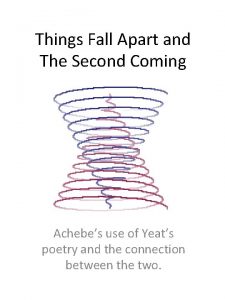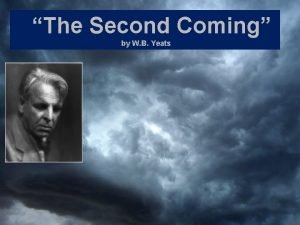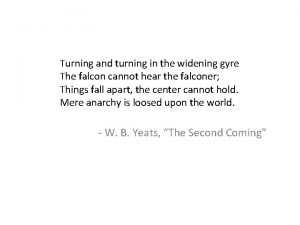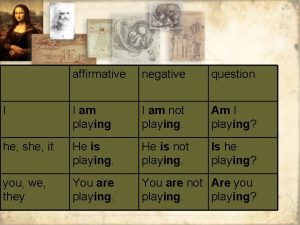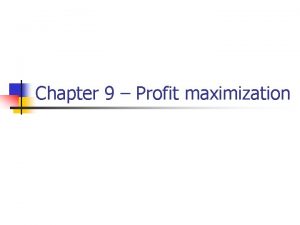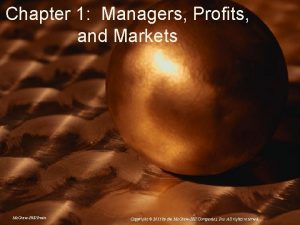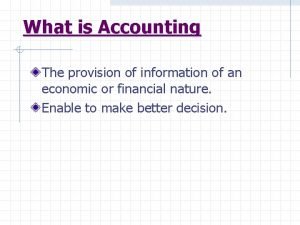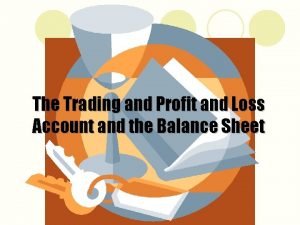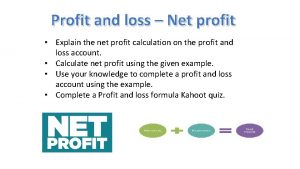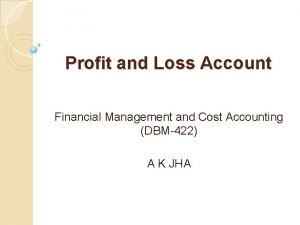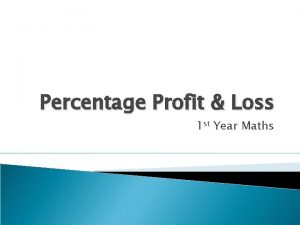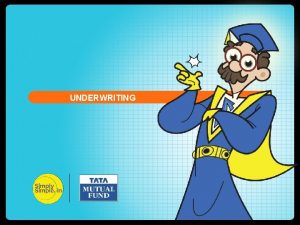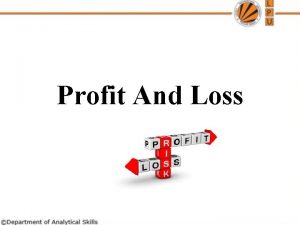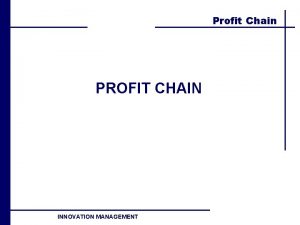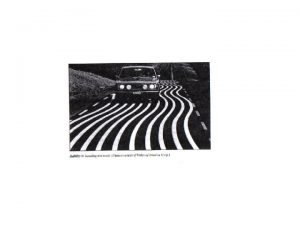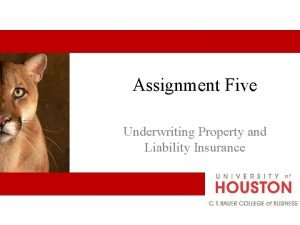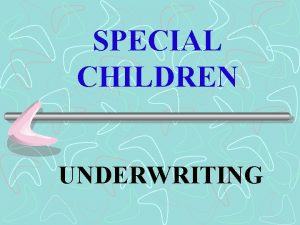Negative underwriting loss turning into positive profit Explore














- Slides: 14

Negative underwriting loss turning into positive profit — Explore the role of investment income for U. S. Property and Casualty insurers Shuang Yang Department of Risk, Insurance and Healthcare Management Fox School of Business, Temple University 18 th APRIA Annual Conference Moscow State University, Moscow July 27 - 30, 2014

Background and Motivation 20% 15% 10% 5% Underwriting income 19 7 7 19 8 7 19 9 8 19 0 8 19 1 8 19 2 83 19 8 19 4 8 19 5 8 19 6 8 19 7 8 19 8 89 19 0 9 19 1 92 19 9 19 3 9 19 4 9 19 5 9 19 6 9 19 7 9 19 8 9 20 9 0 20 0 01 20 0 20 2 0 20 3 0 20 4 0 20 5 0 20 6 0 20 7 0 20 8 0 20 9 1 20 0 1 20 1 12 0% investment income -5% Net profit -10% -15% -20% • Insurers underwriting income is subject to cycles, involving the alternation of hard and soft markets • On industry level, despite continuous years’ negative underwriting results, U. S. Property and Casualty insurers could still maintain a positive net income because of their positive investment income

Our Research • What is the determinant factors of investment income for U. S. Property. Casualty insurers? Ø On the firm-level, explore the factors that affect the amount of insurers’ investment income • What is the role of investment income for U. S. Property- Casualty insurers? ØExtra profit? ØA compensation for the underwriting loss? ØTo produce a long-term source of income so that they could make insurance premium more affordable?

Hypothesis Development • H 1: Insurers’ investment income is affected by their firm-specific characteristics as well as capital market conditions • H 2: Insurers’ investment income plays a role in their total revenue Ø H 2 a: Insurers invest money to earn extra profits Ø H 2 b: Insurers invest money to offset negative underwriting losses to strike a balance

Data and Sample • Data for this analysis include ØNational Association of Insurance Committee (NAIC) database: insurer characteristic ØBest’s Key Rating Guide(BKG): firm level underwriting and investment information ØCenter for Research in Security Prices (CRSP): returns of the value-weighted market portfolios ØFederal Reserve Economic Data (FRED): risk-free rate • Sample: U. S. Property and Casualty insurers from 1999 to 2013 ØTime span: 15 years in total ØSample size: over 20, 000 firm-year observations ØSample selection criterion: exclude firm with missing values to construct a balanced panel

Methodology •

Methodology • Definition of variables: ØDependent variable: o Investment income-- amount of net investment income for each insurer in our sample ØIndependent variables are divided into three categories: o Financial quality related variables: − Firm Size: Ln(Total Asset); Best’s Key Rating Grade; Net Leverage ratio o Other firm-specific variables: − Lagged loss reserve; Proportion of investment into risky asset; Organizational form; Distribution system o Control variables for market condition: − Interest rate

Summary Statistics Variables Mean STD Min Max Net Investment Incomet 2530. 821 2445. 940 -398. 0 9996. 0 Loss Reservet-1 52. 555 45. 959 -99. 9 100. 0 Ln(Asset)t 11. 483 1. 896 5. 89 18. 66 High_Gradet 0. 673 0. 469 0 1 Direct Dummyt 0. 190 0. 392 0 1 Stock Dummyt 0. 746 0. 435 0 1 Net Leveraget 2. 61 1. 770 -0. 3 12. 9 High_riskt 70. 318 19. 172 0 163 Interest Ratet 2. 569 1. 99 0. 14 6. 07

Empirical Results Variables Definition Estimates Ln (Total Asset) 64. 246*** High_Grade Equals to one if the firm has a Best rating above A- and zero otherwise 51. 164*** Net Leverage Net premiums written divided by policyholders’ surplus 64. 572*** The amount of loss reserve in the previous year 1. 363*** Stock Dummy Equals to one if the insurer is a stock company and zero otherwise 9. 870*** Direct Dummy Equals to one if insurer writing business directly and zero otherwise Firm Size Lagged loss Reserve High_risk Interest Rate 3. 957 Percentage of investment into stock and derivative market 1. 103*** Risk-free rate 6. 734***

The role of investment income? • Explore the role of investment income to insurers: a preliminary analysis using correlation matrix ØCorrelation matrix of underwriting income, investment income and the net profit Pearson Correlation Coefficients Matrix Underwriting Income Investment Income Net Profit Underwriting Income 1. 00000 Investment Income Net Profit -0. 64707*** (0. 0001) 1. 00000 0. 95950*** (0. 0001) -0. 40610** (0. 0140) 1. 00000 Number of Observations: N = 36

Discussion • Main takeaway: ØUnderwriting results appears to be negatively correlated with investment income but highly positively correlated with the net profit ØIn years when insurer suffers from severe underwriting losses, the investment income tend to increase • A review over the hypothesis H 2: ØH 2 a states that investment income is intended to earn excessive profits and H 2 b claims that insurers make investment to compensate for the underwriting losses ØH 2 b is favored over H 2 a to interpret the outcome based on the evidence from correlation matrix

Discussion • Why insurers can maintain a stable investment income despite their negative underwriting income? Ø Different operating mechanism between underwriting and investment business Ø Insurance companies generally employ more conservative investment strategies thus their investment results are subject to less fluctuations Ø Insurers maintain a relatively low level of leverage and high amount of capital to back their obligations to their policyholders and this would require more financial solidity and stability Ø…

Conclusion • Insurer’ investment income is related to their firm-specific characteristics: ØPositively associated with the financial quality related variables, including firm size, Best’s financial rating score, and net leverage ratio ØLagged loss reserve has a significant positive impact on the outcome ØStock insurers normally earn higher investment income than mutual insurers ØDistribution system have no significant impact on net investment income • Based on our empirical findings: ØThe role of investment income is more to compensate for underwriting losses than making excessive profits since we’ve detected a strong negative correlation between investment income and underwriting income

Thank you for your attention! Shuang Yang Shuang. yang@temple. edu
 Second coming
Second coming The second coming by w.b yeats
The second coming by w.b yeats Turning and turning in the widening gyre
Turning and turning in the widening gyre Transform the positive sentences below into negative form
Transform the positive sentences below into negative form Divide the following adjectives into positive and negative
Divide the following adjectives into positive and negative Profit maximization
Profit maximization Economic profit vs accounting profit
Economic profit vs accounting profit Post acquisition profit is which profit
Post acquisition profit is which profit Balance carried forward
Balance carried forward Trading account vertical format
Trading account vertical format Juice bar profit and loss statement
Juice bar profit and loss statement Learning outcomes of profit and loss
Learning outcomes of profit and loss Profit and loss formula
Profit and loss formula Trading profit and loss account
Trading profit and loss account Cummins sports football boots
Cummins sports football boots
